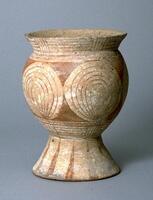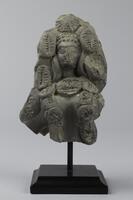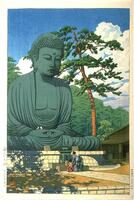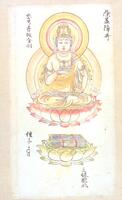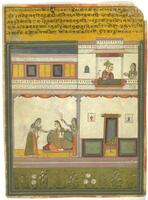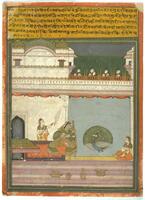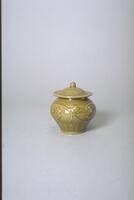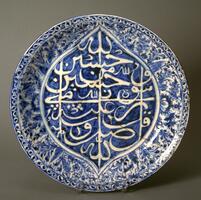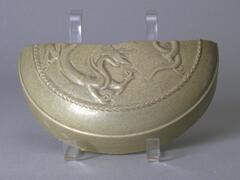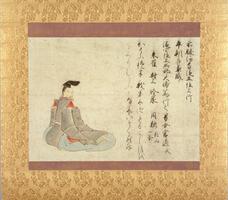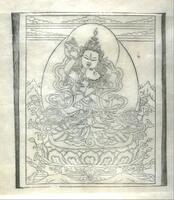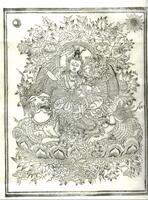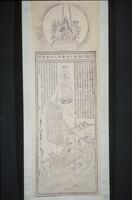27 Items in this Learning Collection
Collection Object
Collection Object
Collection Object
Collection Object
Collection Object
Collection Object
Collection Object
Collection Object
Collection Object
Collection Object
Collection Object
Collection Object
Collection Object
Collection Object
Collection Object
Collection Object
Collection Object
Collection Object
Collection Object
Collection Object
Collection Object
Collection Object
Collection Object
Collection Object
Collection Object
Resource with 12 media
Copyright
All Rights Reserved
()
Ragamala series: Ragini Gujari
Accession Number
1975/2.157
Title
Ragamala series: Ragini Gujari
Artist(s)
Artist Unknown, India, Rajasthan, Jaipur School
Object Creation Date
circa 1750
Medium & Support
ink, opaque watercolor, and gold on paper
Dimensions
10 15/16 in x 8 in (27.8 cm x 20.3 cm);10 15/16 in x 8 in (27.8 cm x 20.3 cm)
Credit Line
Gift of Dr. and Mrs. Leo S. Figiel and Dr. and Mrs. Steven J. Figiel.
Label copy
Jaipur School
Ragamala series: Ragini Patamanjari; Kukubha ragini;
Ragini Gujari
India, Rajasthan
ca. 1750
Ink, opaque watercolor, and gold on paper
Gift of Dr. and Mrs. Leo S. Figiel and Dr. and Mrs. Steven J. Figiel,
1975/2.161; 1975/2.153; 1975/2.157
Gujari ragini:
Caupayī: The Creator had put together all his wits to picture the
handsome sprightly Gujarī. A confidante sits in front and recites
verse (or plays on the vīna). Her song induces drizzling rain,
and her sight delights the heart of her lover. There is a peacock
shining in its nimble movements, its voice so sweet, captivates
the heart, we have never seen a second lady so beautiful, the love
of the life of her beloved lover.
Dohā: Covering her body with a yellow robe, the damsel of bright
complexion sits. She steals one’s heart and makes Megha Mallār
happy.
(translation by Stephen Markel)
Ragamala (meaning “garland of ragas”) paintings
were meant to evoke the same emotional
responses as ragas—short musical phrases that
formed the basis of Indian classical music and
were associated with a particular mood, season,
and time of day. Ragamala paintings would have
been mounted in albums, following the order
of the ragas, which were arranged into families,
headed by the “husband” raga and followed by
the “wife” ragini, and, occasionally, a variety of
children. These three images illustrate scenes
of love and lovesickness, a common theme in
Ragamala painting. They are in the Jaipur school
style, known for its vivid colors, idealized human
figures, and detailed, yet abbreviated landscapes.
The Ragamala paintings shown here include
both visual imagery and texts. The source of
the text is unknown, but versions of it appear
in many Ragamala paintings from this period.
Known as meditation aids (dhyāna-mantra),
these texts shed light on the main theme of the
images. Each is comprised of a rhyming quatrain
(caupayī) that describes the narrative shown in the
image, followed by a rhyming couplet (dohā) that
summarizes the meaning of the musical phrase,
the poem, and the image. The text is written in
Malvī, a subdialect spoken in central India around
Bundelkhand.
Subject matter
Ragamala paintings draw from aspects of human experience in order to visualize specific moods, emotions, and qualities such as love, anguish, valor, weakness, and strength. A raga in Indian music is a melody consisting of a string of notes in a particular arrangement. Raginis are derivations from or variations of ragas in feminine mode (the basis of these classifications remains unexplained in many cases), and could have different or similar musical structures as ragas. Specific ragas are associated with specific times of the day, seasons, and emotions. When visualized, as here, ragas and raginis are meant to evoke the same affective responses that are allied to their musical modes. The text above the illustration refers to stories or incidents associated with the depicted raga/ ragini, but may not necessarily be narrative-like or descriptive. Drawn from literary tropes and tales that sophisticated writers and viewers would be aware of, the inscriptions are an integral part of the overall experience of this miniature painting. An illiterate viewer, however, could still enjoy the scene without reading the text.
Gujari Ragini is a morning melody of the monsoon season, representing the sorrow of separation. In this image, the woman is shown playing an instrument (the text says it is a veena), as the woman seen in the right-hand side recites verse. The peacock perhaps symbolizes her absent lover.
Physical Description
A lady plays a musical instrument (most probably the rudra vina) in the center-left of the composition. Within the palace setting are also two attendants--one standing with a fly whisk above her mistress's head, the other seated in the right edge of the picture. A peacock with his feathers on full display is depicted in the center-left of the image, amidst the action enveloping the female figures. Utensils are placed on the staircase below the scene.
Primary Object Classification
Painting
Collection Area
Asian
Rights
If you are interested in using an image for a publication, please visit http://umma.umich.edu/request-image for more information and to fill out the online Image Rights and Reproductions Request Form. Keywords
Musical instruments
Vessels
buildings
calligraphy
flowers
musical instruments
peacocks
seated
torch
1975/2.157
Title
Ragamala series: Ragini Gujari
Artist(s)
Artist Unknown, India, Rajasthan, Jaipur School
Object Creation Date
circa 1750
Medium & Support
ink, opaque watercolor, and gold on paper
Dimensions
10 15/16 in x 8 in (27.8 cm x 20.3 cm);10 15/16 in x 8 in (27.8 cm x 20.3 cm)
Credit Line
Gift of Dr. and Mrs. Leo S. Figiel and Dr. and Mrs. Steven J. Figiel.
Label copy
Jaipur School
Ragamala series: Ragini Patamanjari; Kukubha ragini;
Ragini Gujari
India, Rajasthan
ca. 1750
Ink, opaque watercolor, and gold on paper
Gift of Dr. and Mrs. Leo S. Figiel and Dr. and Mrs. Steven J. Figiel,
1975/2.161; 1975/2.153; 1975/2.157
Gujari ragini:
Caupayī: The Creator had put together all his wits to picture the
handsome sprightly Gujarī. A confidante sits in front and recites
verse (or plays on the vīna). Her song induces drizzling rain,
and her sight delights the heart of her lover. There is a peacock
shining in its nimble movements, its voice so sweet, captivates
the heart, we have never seen a second lady so beautiful, the love
of the life of her beloved lover.
Dohā: Covering her body with a yellow robe, the damsel of bright
complexion sits. She steals one’s heart and makes Megha Mallār
happy.
(translation by Stephen Markel)
Ragamala (meaning “garland of ragas”) paintings
were meant to evoke the same emotional
responses as ragas—short musical phrases that
formed the basis of Indian classical music and
were associated with a particular mood, season,
and time of day. Ragamala paintings would have
been mounted in albums, following the order
of the ragas, which were arranged into families,
headed by the “husband” raga and followed by
the “wife” ragini, and, occasionally, a variety of
children. These three images illustrate scenes
of love and lovesickness, a common theme in
Ragamala painting. They are in the Jaipur school
style, known for its vivid colors, idealized human
figures, and detailed, yet abbreviated landscapes.
The Ragamala paintings shown here include
both visual imagery and texts. The source of
the text is unknown, but versions of it appear
in many Ragamala paintings from this period.
Known as meditation aids (dhyāna-mantra),
these texts shed light on the main theme of the
images. Each is comprised of a rhyming quatrain
(caupayī) that describes the narrative shown in the
image, followed by a rhyming couplet (dohā) that
summarizes the meaning of the musical phrase,
the poem, and the image. The text is written in
Malvī, a subdialect spoken in central India around
Bundelkhand.
Subject matter
Ragamala paintings draw from aspects of human experience in order to visualize specific moods, emotions, and qualities such as love, anguish, valor, weakness, and strength. A raga in Indian music is a melody consisting of a string of notes in a particular arrangement. Raginis are derivations from or variations of ragas in feminine mode (the basis of these classifications remains unexplained in many cases), and could have different or similar musical structures as ragas. Specific ragas are associated with specific times of the day, seasons, and emotions. When visualized, as here, ragas and raginis are meant to evoke the same affective responses that are allied to their musical modes. The text above the illustration refers to stories or incidents associated with the depicted raga/ ragini, but may not necessarily be narrative-like or descriptive. Drawn from literary tropes and tales that sophisticated writers and viewers would be aware of, the inscriptions are an integral part of the overall experience of this miniature painting. An illiterate viewer, however, could still enjoy the scene without reading the text.
Gujari Ragini is a morning melody of the monsoon season, representing the sorrow of separation. In this image, the woman is shown playing an instrument (the text says it is a veena), as the woman seen in the right-hand side recites verse. The peacock perhaps symbolizes her absent lover.
Physical Description
A lady plays a musical instrument (most probably the rudra vina) in the center-left of the composition. Within the palace setting are also two attendants--one standing with a fly whisk above her mistress's head, the other seated in the right edge of the picture. A peacock with his feathers on full display is depicted in the center-left of the image, amidst the action enveloping the female figures. Utensils are placed on the staircase below the scene.
Primary Object Classification
Painting
Collection Area
Asian
Rights
If you are interested in using an image for a publication, please visit http://umma.umich.edu/request-image for more information and to fill out the online Image Rights and Reproductions Request Form. Keywords
Musical instruments
Vessels
buildings
calligraphy
flowers
musical instruments
peacocks
seated
torch

